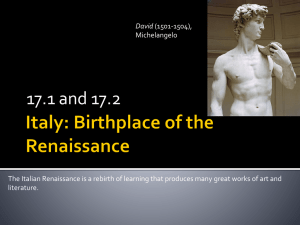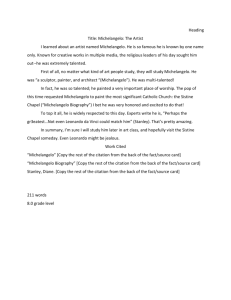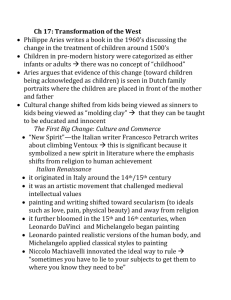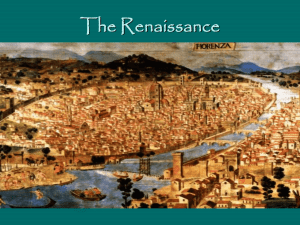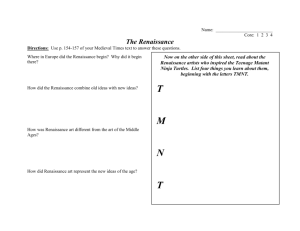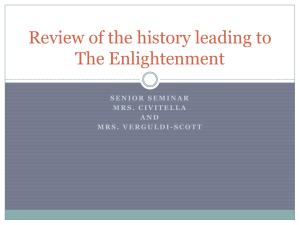File - MrPadilla.net
advertisement
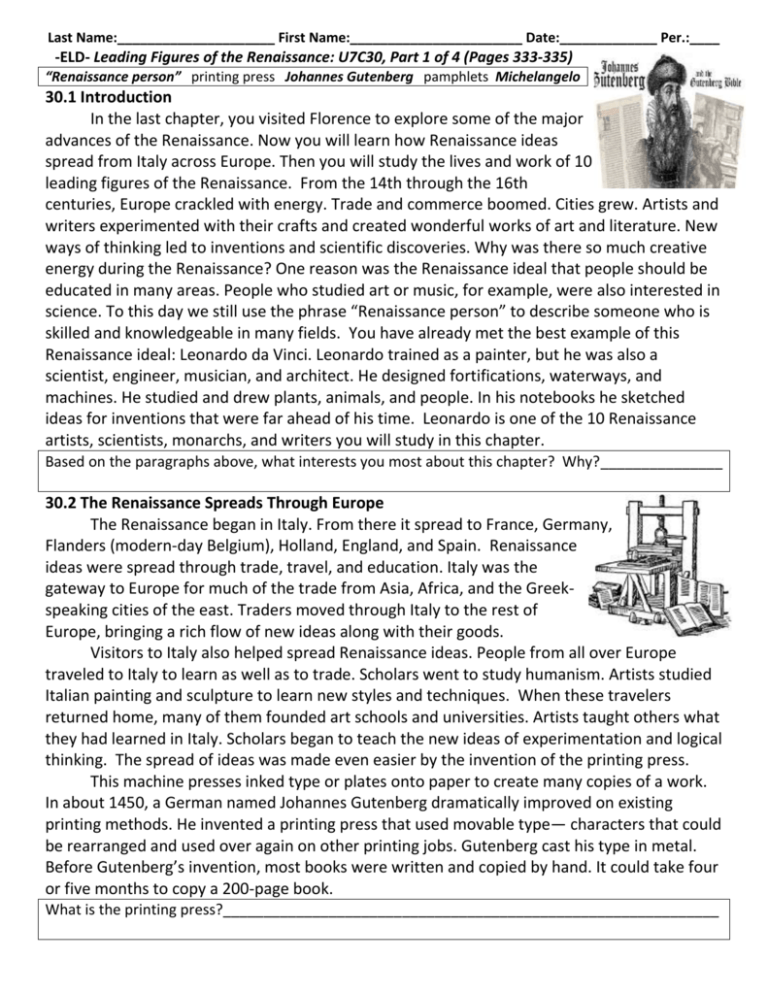
Last Name:_____________________ First Name:_______________________ Date:_____________ Per.:____ -ELD- Leading Figures of the Renaissance: U7C30, Part 1 of 4 (Pages 333-335) “Renaissance person” printing press Johannes Gutenberg pamphlets Michelangelo 30.1 Introduction In the last chapter, you visited Florence to explore some of the major advances of the Renaissance. Now you will learn how Renaissance ideas spread from Italy across Europe. Then you will study the lives and work of 10 leading figures of the Renaissance. From the 14th through the 16th centuries, Europe crackled with energy. Trade and commerce boomed. Cities grew. Artists and writers experimented with their crafts and created wonderful works of art and literature. New ways of thinking led to inventions and scientific discoveries. Why was there so much creative energy during the Renaissance? One reason was the Renaissance ideal that people should be educated in many areas. People who studied art or music, for example, were also interested in science. To this day we still use the phrase “Renaissance person” to describe someone who is skilled and knowledgeable in many fields. You have already met the best example of this Renaissance ideal: Leonardo da Vinci. Leonardo trained as a painter, but he was also a scientist, engineer, musician, and architect. He designed fortifications, waterways, and machines. He studied and drew plants, animals, and people. In his notebooks he sketched ideas for inventions that were far ahead of his time. Leonardo is one of the 10 Renaissance artists, scientists, monarchs, and writers you will study in this chapter. Based on the paragraphs above, what interests you most about this chapter? Why?_______________ 30.2 The Renaissance Spreads Through Europe The Renaissance began in Italy. From there it spread to France, Germany, Flanders (modern-day Belgium), Holland, England, and Spain. Renaissance ideas were spread through trade, travel, and education. Italy was the gateway to Europe for much of the trade from Asia, Africa, and the Greekspeaking cities of the east. Traders moved through Italy to the rest of Europe, bringing a rich flow of new ideas along with their goods. Visitors to Italy also helped spread Renaissance ideas. People from all over Europe traveled to Italy to learn as well as to trade. Scholars went to study humanism. Artists studied Italian painting and sculpture to learn new styles and techniques. When these travelers returned home, many of them founded art schools and universities. Artists taught others what they had learned in Italy. Scholars began to teach the new ideas of experimentation and logical thinking. The spread of ideas was made even easier by the invention of the printing press. This machine presses inked type or plates onto paper to create many copies of a work. In about 1450, a German named Johannes Gutenberg dramatically improved on existing printing methods. He invented a printing press that used movable type— characters that could be rearranged and used over again on other printing jobs. Gutenberg cast his type in metal. Before Gutenberg’s invention, most books were written and copied by hand. It could take four or five months to copy a 200-page book. What is the printing press?_____________________________________________________________ The new press could produce 300 pages in a single day. As a result, books and short works called pamphlets could be made much more quickly and cheaply. The number of printers in Europe soon increased rapidly. People used printed matter to spread new ideas, discoveries, and inventions. And since printed material was more widely available, more people learned to read. As new ideas spread, people in more countries were swept up in the spirit of the Renaissance. 30.3 Michelangelo, Italian Sculptor and Painter You met Michelangelo (1475– 1564) in Chapter 29. Michelangelo was born in a small village near Florence. He grew up to become one of the greatest painters and sculptors in history. Personality and Training- Historians say that Michelangelo had a difficult childhood. His mother died when he was six years old. His father was stern and demanding. Perhaps this troubled early life contributed to Michelangelo’s famously bad temper. Although he was very religious, he was known to use fierce words when he was angry. He was also intensely ambitious. When Michelangelo was 13, he became an apprentice to a painter in Florence. At 15, he began studying under a sculptor who worked for the powerful Medici family. Michelangelo lived for a time in the Medici household. There he met many leading thinkers, artists, and writers. Talents and Achievements- Michelangelo was amazingly gifted in both sculpture and painting. His art combines ideal beauty with emotional expressiveness. To other artists, Michelangelo’s talent seemed almost godlike. Michelangelo’s sculptures show his amazing talent for bringing life to figures carved from giant blocks of marble. When he was just 24, he carved his famous Pieta. A pieta is a depiction of Mary, the mother of Jesus, mourning over her crucified son. Michelangelo’s Pieta 1) Total Words Read:___ shows Mary holding the body of Jesus on her lap. 1) Mistakes:_______ Two other magnificent sculptures by Michelangelo are his David and 1) Total Correct:______ Moses. As you learned in Chapter 29, David is 17 feet tall. The statue 2) Total Words Read:___ combines great beauty with the intense look of a youth who is about to go 2) Mistakes:_______ into battle. Michelangelo’s Moses is also a strong, powerful figure. In the 2) Total Correct: Bible, Moses receives the Ten Commandments from God. Meanwhile his people, the Hebrews, are worshiping false gods. The expression of Michelangelo’s Moses is a mixture of compassion and anger. Michelangelo is perhaps best known for painting the ceiling of the Sistine Chapel, the pope’s chapel in Rome. Michelangelo labored for almost four years to complete this work. He covered the ceiling with brilliantly colored scenes from the Bible. The scenes contain over 300 figures. What was Michelangelo’s most important accomplishment? Why? ____________________________ ___________________________________________________________________________________ In your own words, write down the meaning of the words below: “Renaissance person” :________________________________________________________________ printing press:_______________________________________________________________________ Johannes Gutenberg:__________________________________________________________________ pamphlets:__________________________________________________________________________ Michelangelo:_______________________________________________________________________

